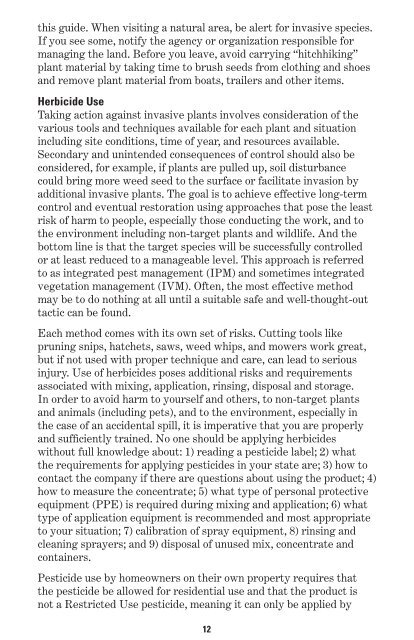Plant Invaders of Mid-Atlantic Natural Areas - National Park Service
Plant Invaders of Mid-Atlantic Natural Areas - National Park Service
Plant Invaders of Mid-Atlantic Natural Areas - National Park Service
You also want an ePaper? Increase the reach of your titles
YUMPU automatically turns print PDFs into web optimized ePapers that Google loves.
this guide. When visiting a natural area, be alert for invasive species.<br />
If you see some, notify the agency or organization responsible for<br />
managing the land. Before you leave, avoid carrying “hitchhiking”<br />
plant material by taking time to brush seeds from clothing and shoes<br />
and remove plant material from boats, trailers and other items.<br />
Herbicide Use<br />
Taking action against invasive plants involves consideration <strong>of</strong> the<br />
various tools and techniques available for each plant and situation<br />
including site conditions, time <strong>of</strong> year, and resources available.<br />
Secondary and unintended consequences <strong>of</strong> control should also be<br />
considered, for example, if plants are pulled up, soil disturbance<br />
could bring more weed seed to the surface or facilitate invasion by<br />
additional invasive plants. The goal is to achieve effective long-term<br />
control and eventual restoration using approaches that pose the least<br />
risk <strong>of</strong> harm to people, especially those conducting the work, and to<br />
the environment including non-target plants and wildlife. And the<br />
bottom line is that the target species will be successfully controlled<br />
or at least reduced to a manageable level. This approach is referred<br />
to as integrated pest management (IPM) and sometimes integrated<br />
vegetation management (IVM). Often, the most effective method<br />
may be to do nothing at all until a suitable safe and well-thought-out<br />
tactic can be found.<br />
Each method comes with its own set <strong>of</strong> risks. Cutting tools like<br />
pruning snips, hatchets, saws, weed whips, and mowers work great,<br />
but if not used with proper technique and care, can lead to serious<br />
injury. Use <strong>of</strong> herbicides poses additional risks and requirements<br />
associated with mixing, application, rinsing, disposal and storage.<br />
In order to avoid harm to yourself and others, to non-target plants<br />
and animals (including pets), and to the environment, especially in<br />
the case <strong>of</strong> an accidental spill, it is imperative that you are properly<br />
and sufficiently trained. No one should be applying herbicides<br />
without full knowledge about: 1) reading a pesticide label; 2) what<br />
the requirements for applying pesticides in your state are; 3) how to<br />
contact the company if there are questions about using the product; 4)<br />
how to measure the concentrate; 5) what type <strong>of</strong> personal protective<br />
equipment (PPE) is required during mixing and application; 6) what<br />
type <strong>of</strong> application equipment is recommended and most appropriate<br />
to your situation; 7) calibration <strong>of</strong> spray equipment, 8) rinsing and<br />
cleaning sprayers; and 9) disposal <strong>of</strong> unused mix, concentrate and<br />
containers.<br />
Pesticide use by homeowners on their own property requires that<br />
the pesticide be allowed for residential use and that the product is<br />
not a Restricted Use pesticide, meaning it can only be applied by<br />
12

















